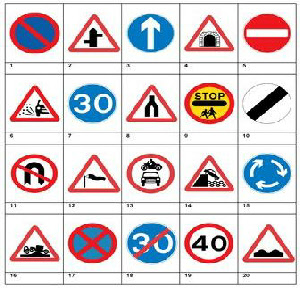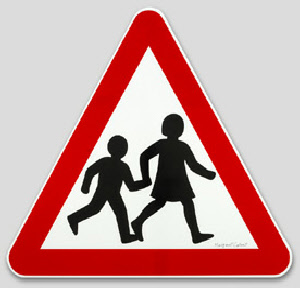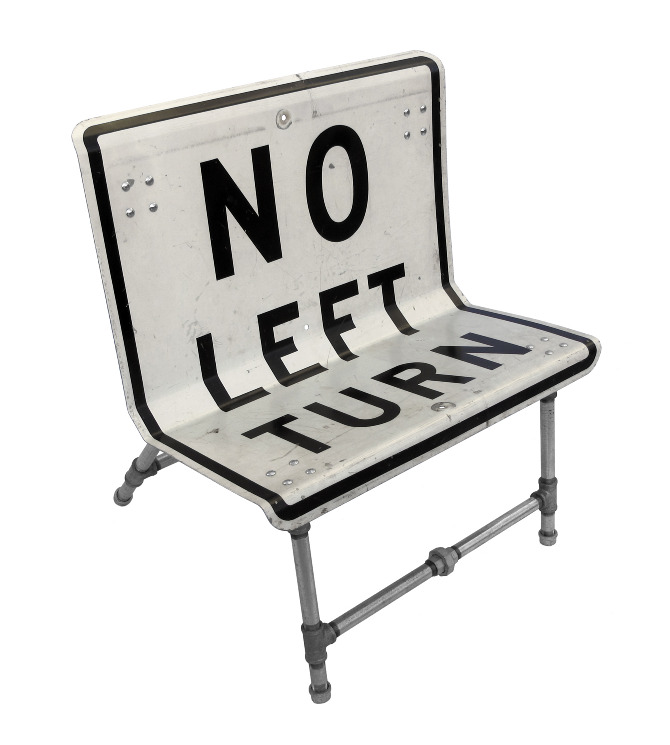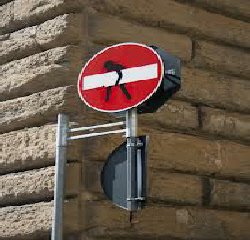Street Art

The Highway Code features a huge amount of signage and signals, and there is a 144-page booklet detailing the types of signs and their usage. We drive past hundreds, if not thousands of road signs every day, and yet who pays any attention to them, beyond their immediate message? But to understand how these signs were designed and used, we must look at their function.
Originally for warning cyclists of dangers in the area, road signs were being put up by Cycling Clubs (notably the CTC, NCU and SCU) through the 1880s. In 1888, they had successfully lobbied Government to take responsibility for the roads, and County Councils were tasked with erecting signs, warnings and mileposts. The rising car use of the early 20th Century saw the AA and RSAC putting up signs for motorists, and in 1930 the advisory Road Traffic Act was passed, beginning the standardisation of signs across the country. In 1957, Jock Kinneir and Margaret Calvert were tasked by The Anderson Committee to produce new signs for Britain’s roads, and a new set of clear, informative images were designed, specifically with the new high-speed “motorways” in mind.
It is quite a difficult task to design easy-to-read, easily understood signage, meant for reading while driving, and it is of great credit to the designers that after the Warboys Committee report of 1964 standardised them, very little has changed about our Road Signs. With red-bordered circles for instructions, red-bordered triangles for warnings and blue rectangles for directions, our roads became a safer place for all.

As with any images, the designs on road signs may mean different things to different people, especially with differing cultural backgrounds. It takes quite some effort to co-ordinate across Europe to teach all learner drivers the same, or at least similar, signage and ensure that types of sign are consistent. Tolls are used more in some countries than others, and the methods of informing drivers vary considerably. The yellow diamond, used in Mainland Europe to signify priority, is not seen in the UK, and most British drivers are unaware of its significance. Only some countries use the diagonal red bar across a prohibition sign. While most countries have only minor differences, one major issue can be that Speed Limits are measured in either kmph or mph. Luckily, most of Europe does not need “Beware, Dung Beetles” or “Warthogs Have Right of Way” signs. Be aware, if you are travelling in more exotic lands!
While many people do not consider such signage as Art, being almost entirely focused on its functionality and the clear, easy transmission of simple information (there is very little interpretation needed for a “Danger – Slippery Road” warning, and little left to the imagination in a “No Entry” sign), there is still room to appreciate the effort put into them. Margaret Calvert’s “Farm Animals Ahead” sign was modelled on a cow she knew called ‘Patience’, and her “School Crossing” design was based upon a photograph of herself as a child, giving the otherwise utilitarian signage a personal, friendly touch. Other of her designs are considered gently playful, even while issuing serious warnings or prohibitions.
She also helped to design the new typeface, Transport, using softer curves and incorporating lower-case lettering, deeming this to be a more welcoming appearance, rather than the previously draconian block-capitals, as well as being easier to recognise at a glance.


Taken out of context, reused in new and innovative ways, or just altered slightly, road signs can take on an artistic side, helped along by a creative mind. Clet Abraham is perhaps the best known of these Artists, altering existing signs in an attempt to lighten their mood, while still retaining their function. It is argued (mainly by Council Officers) that such vandalism undermines the authority of the signs and endangers lives by obscuring their message, but who can pass a “No Entry” sign made to look like the white bar is being carried by a stick man without raising a smile?
Tim Delger, on the other hand, takes signs and transforms them into furniture. Fully-functional, decorative, and possibly with some kind of message, these pieces certainly stand out.